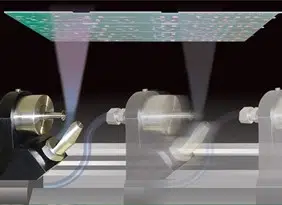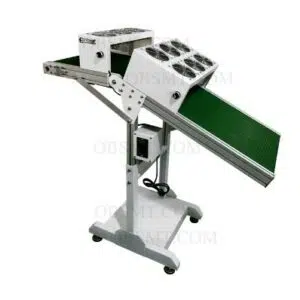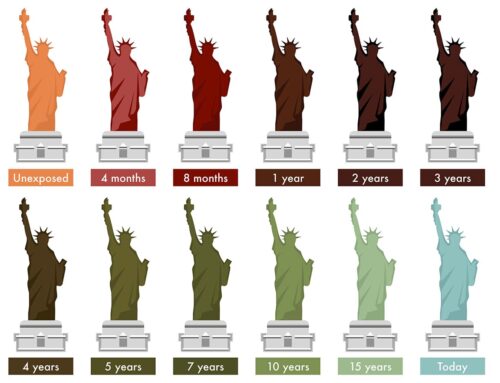Nowadays almost all electronic products are soldered fully automatically. This is possible with soldering machines such as: wave soldering machines, reflow ovens, selective soldering, pin-in-paste soldering, vapor phase soldering, laser soldering, soldering robots, etc. In this article we describe the operation of wave soldering and reflow soldering.
Wave soldering
Wave soldering machines are mainly used for THT (Through-Hole Technology), components that (manually or fully automatically) are inserted through the printed circuit board at the top and soldered at the bottom by means of soldering in a liquid solder wave (solder pot).
Schematic of a wave soldering machine:

Step 1 Flux application:
The first step in this machine is flux application. This is usually done by a spray fluxer. The spray nozzle moves back and forth and sprays the flux against the underside of the assembled circuit board.

Step 2 Preheating:
Then the assembled circuit board is heated to activate the flux.

Step 3 Wave soldering:
When the flux activation temperature is reached, the assembled circuit board passes through the solder wave and the solder flows up through the plated holes to the top side of the circuit board.

Step 4 Cooling:
Finally, the soldered assembled circuit board is cooled and cleaned. The assembly is now ready for inspection and functional test.

The SMD components (surface mounted devices where the leads are not inserted through the printed circuit board) can also be soldered with a wave soldering machine provided they are located on the bottom side of the printed circuit board. These small components are glued and go through the liquid solder wave. For the smallest SMD components, the wave soldering machine has a separate (rough) wave, the so-called CHIP wave:


However, nowadays more and more SMD components are used and the Reflowoven is the better solution for this.
Reflow soldering
With ever smaller equipment and the miniaturization of components, products are getting smaller and faster. All this thanks to the SMT (Surface Mount Technology). The reflow oven is used for these components (SMD = Surface Mounted Devices).
Scheme of a reflow soldering process:

Step 1 Solder paste printing:
After mixing and acclimating the solder paste, it is manually/automatically applied to the stencil and pressed through the stencil with a squeegee. Each pad is now covered with solder paste.

Step 2 Component placement in solder paste:
The components are placed fully automatically with a pick-and-place machine or with a CHIP shooter on the lands on the printed circuit board covered with solder paste. The latest machines can place up to 40,000 components/hour (more than 10 components/second).
Ultra High Speed Pick and Place Machine:


Step 3 Preheating:
The assembled printed circuit board is transported over the conveyor belt to the reflow oven.
Scheme of a reflow oven:

The first part is the preheat zone where all the activators of the flux in the solder paste are activated. The following diagram shows a reflow profile with all 4 phases in the reflow oven:


Step 4 Soak (stabiliseren):
At the end of the preheat cycle, all the small SMD components are heated up, but the large SMD components are not fully heated up. Therefore, the temperature is kept constantly to better distribute the heat. They call this the soak phase. At the end of this phase, all components are at the same temperature and now the temperature is rising up to the melting point of the solder alloy. The real reflow soldering starts (the solder paste melts).


Step 5 Reflow soldering:
The peak zone is the zone where the solder paste melts. After this, all components are soldered.

Step 6 Cooling:
And the last step is cooling the soldered assembly.

The printed circuit board assembly (PCBA) will be cleaned (if necessary) and inspected and tested.






